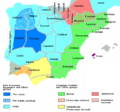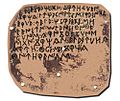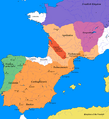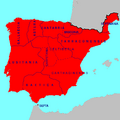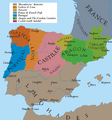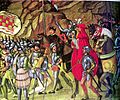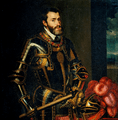History of Spain facts for kids
Contents
Early History
People have lived on the Iberian Peninsula for about 500,000 years. Neanderthal man came about 200,000 years ago. Modern humans first came about 40,000 years. Thousands of years ago Iberians and Celts lived there, and the Phoenicians made a few cities there to get tin and silver to trade.
The Roman Empire controlled Spain for three hundred years; then people from Eastern Europe called Visigoths fought for Spain, won it from the Romans, and controlled Spain for over two hundred years.
As was the rest of the Western Roman Empire, Spain was invaded by Germanic tribes during the 4th and 5th centuries CE/ As a result, the Roman rule ended and many Germanic kingdoms, most notably the Visigoths and the Suebi, were established. That marked the beginning of the Middle Ages in Spain.

8th century
In 711, the Umayyad conquest of Hispania began and brought Islam to the Iberian Peninsula. The region became known as Al-Andalus and remained under the control of Muslim-lead states for much of the Early Middle Ages, a period known as the Islamic Golden Age. The only part that remained Christian was the small Kingdom of Asturias in the north of Iberia.
Roman Catholics from Europe eventually decided to fight to take Spain from the Muslims. They fought wars for almost 800 years, some of which were Crusades against other Christians like the Cathars. These were very cruel wars. This period later was named the Reconquista.
Late 15th century
By the time of the High Middle Ages, Christians from the north gradually expanded their control over Iberia. А number of Christian kingdoms were formed, including the Kingdom of Navarre (a Basque kingdom centered on the city of Pamplona), the Kingdom of León (in the northwest, originally an offshoot of, and later supplanting, the Kingdom of Asturias), the Kingdom of Castile (in central Iberia), and the Kingdom of Aragon (in Catalonia and surrounding areas of Eastern Iberia). The history of these kingdoms and other are intertwined and they eventually consolidated into two roughly equivalent polities, the Crown of Castile and the Crown of Aragon. The two kingdoms roughly occupied the central and eastern thirds of the Iberian Peninsula respectively.
During this period, the southwestern portion of the Peninsula developed into the Kingdom of Portugal, and developed its own distinct national identity separate from that of Spain.
In the year 1492, the Christian kigs took the last part of Spain, the Nasrid kingdom of Granada, that had belonged to the Moors and was Muslim. Boabdil, the last Moorish Leader of Granada, gave the city to King Ferdinand of Aragon on 2 January 1492, and Christians now ruled all of Spain.
Before this, Castile and Aragon, came together when the king of Aragon, Ferdinand II, married the queen of Castile, Isabella.
In the same year, 1492, they decided to send Christopher Columbus to explore the Atlantic Ocean. Columbus found a land there that the people of Europe did not yet know. These were the islands of the Caribbean Sea.Columbus and other sailors explored more and found that there were two continents there - North America and South America. Spain sent many soldiers and businessmen to North and South America, and they took over very large parts of those two continents. Owning this empire made Spain very rich. But when they conquered that empire, they killed millions of the Native Americans who had lived there before. Spain owned this empire for more than three hundred years.
Meanwhile, at home, the Muslim manuscripts had been either burnt or spread to other countries. Jews had been expelled from Spain. The multicultural society was destroyed, and so was the learning. Among the few things kept and respected in Spain were in music: harmony and stringed instruments, and of course the buildings, many of which became churches, by adding crosses.
16th and 17th centuries
The Spanish Empire was the strongest in the world through most of the next two centuries, thanks to gold from the Americas. This new gold made rulers and colonial governors rich. Meanwhile, others' savings became worth less due to inflation. Spain became a society of very rich and very poor. Some of the poorest went to the new colonies in the Caribbean, Central America and South America, mostly to find gold.
Native American peoples were killed by diseases brought by the Spaniards, but most Spaniards did not know this. They found damaged and dying societies with people who had lost some of their most important leaders and thinkers. The Spaniards thought this meant they were inferior, and used this as an excuse to enslave the natives. Millions of natives died mining gold for the Spanish.
The Spanish Empire also at this time funded the Spanish Inquisition which tortured and killed anyone who disagreed with the Roman Catholic Church. The Reformation which created Protestant sects in Europe was not allowed into Spain, it was kept out and, as with Jews or Muslims, its believers were killed.
The nobles of Spain no longer had to fight anyone since the internal feuds were over. No one could challenge their power. In many ways it was held together as a reign of terror. People who challenged them were often called heretics, so that the Inquisition could torture them, and then nobles take the property.
For ordinary people on both sides of the Atlantic Ocean, life got worse. A few rulers got rich. Today we would say that these people were guilty of war crimes, genocide and crimes against humanity. Many Church people who had the power to speak out at that time, did so, and they said many of the same things as we would say today. But none of this mattered much to the rulers.
The great satire Don Quixote was written about this time.
18th century
In the 18th century, there was doubt over who should become king of Spain; this doubt led many of the kings of Europe to fight to become king of Spain. This was called the War of the Spanish Succession.
France occupied Spain for a long time. This made Spain very weak. It also made Spain lose its empire in North and South America; all of the parts of that empire became their own countries, or were taken over by other countries such as the United States of America.
20th century
There was not much peace in Spain during the first part of the 20th century. Some Spaniards tried to set up a government chosen by the people (a democracy), and they made the King of Spain leave the country. However, in 1936, two different groups of Spaniards went to war over whether the government should be a democracy, or take orders from one person. In 1939, those who wanted democracy were defeated, and a dictator named Francisco Franco took over the government.
Franco died in 1975. He had decided that Spain should have a king again, and he chose Juan Carlos, the grandson of the king who had been forced to leave the country, to be king. But the king did not rule as a dictator; instead, he chose to set up a democracy. Also since Franco's death, Spain appointed Adolfo Suárez to became Spain's first democratically elected prime minister. Now Spain is a modern democratic country, and does business with many countries around the world. It is a part of the European Union.
Images for kids
-
Illustration depicting the (now lost) Luzaga's Bronze, an example of the Celtiberian script.
-
Roman Empire, 3rd century
-
The greatest extent of the Visigothic Kingdom of Toulouse, c. 500, showing Territory lost after Vouillé in light orange
-
Visigothic King Roderic haranguing his troops before the Battle of Guadalete
-
Detail of the votive crown of Recceswinth from the Treasure of Guarrazar, (Toledo-Spain) hanging in Madrid. The hanging letters spell [R]ECCESVINTHVS REX OFFERET [King R. offers this].
-
Visigothic Hispania and its regional divisions in 700, prior to the Muslim conquest
-
The Christian kingdoms of Hispania and the Islamic Almohad empire c. 1210
-
A battle of the Reconquista from the Cantigas de Santa Maria
-
The title page of the Gramática de la lengua castellana (1492), the first grammar of a modern European language to be published.
-
Taking of Oran by Francisco Jiménez de Cisneros in 1509.
-
The Port of Seville in the late 16th century. Seville became one of the most populous and cosmopolitan European cities after the expeditions to the New World.
-
Charles I of Spain (better known in the English-speaking world as the Holy Roman Emperor Charles V) was the most powerful European monarch of his day.
-
A map of Europe in 1648, after the Peace of Westphalia
-
View of Toledo by El Greco, between 1596 and 1600
-
Louis XIV of France and Philip IV of Spain at the Meeting on the Isle of Pheasants in June 1660, part of the process to put an end to the Franco-Spanish War (1635–59).
-
An 18th-century map of the Iberian Peninsula
-
El paseo de las Delicias, a 1784-1785 painting by Ramón Bayeu depicting a meeting of members of the aristocracy in the aforementioned location.
-
The Second of May 1808 was the beginning of the popular Spanish resistance against Napoleon.
-
The promulgation of the Constitution of 1812, oil painting by Salvador Viniegra.
-
The pro-independence forces delivered a crushing defeat to the royalists and secured the independence of Peru in the 1824 battle of Ayacucho.
-
Battle of the First Carlist War, by Francisco de Paula Van Halen
-
Episode of the 1854 Spanish Revolution in the Puerta del Sol, by Eugenio Lucas Velázquez.
-
The explosion of the USS Maine launched the Spanish–American War in April 1898
-
The successful 1925 Alhucemas landing turned the luck in the Rif War towards Spain's favour.
-
Ruins of Guernica
-
Francisco Franco and his appointed successor Prince Juan Carlos de Borbón.
-
Felipe González signing the treaty of accession to the European Economic Community on 12 June 1985.
See also
 In Spanish: Historia de España para niños
In Spanish: Historia de España para niños


